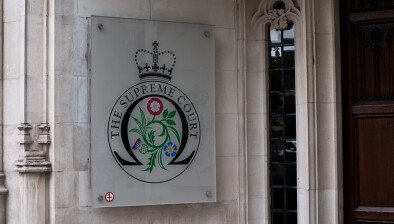NI Coroner’s Court: MoD ‘bears significant responsibility’ for death of 10-year-old boy killed by rubber bullet

Northern Ireland’s Coroner’s Court has found that a rubber baton round which killed Stephen Geddis, “an innocent child”, in 1975 was neither necessary nor justified in the circumstances.

About this case:
- Citation:[2022] NICoroner 2
- Judgment:
- Court:NI Coroner's Court
- Judge:Mr Justice Patrick McGurgan
The danger posed by the use of this weapon near children had not been made apparent to the soldier responsible, although this information had been communicated to the Ministry of Defence.
Background
This inquest concerned the death of Stephen Geddis, a 10-year-old boy who died after he was struck by a type of rubber bullet, on the evening of the 28 August 1975.
In 1976 a verdict of misadventure was recorded, however, a fresh inquest was ordered in 2014, which led to this decision. Previous State investigations established that a possible cause of the head injury was a plastic baton round discharged by a serving soldier.
Central to the inquest were SGM3, the Corporal in charge of the patrol that evening, and SGM15, a Private soldier who appeared to be responsible for the death of Stephen Geddis.
On the evening of 28 August 1975, a barricade had been erected across Albert Street, near its junction with the Cullingtree Road.
A group of teenage and pre-teenage children had gathered in the area, where they threw stones or other objects at the Army vehicle commanded by SGM3 as it passed while patrolling the area.
The patrol was ordered to dismantle the barricade, so they rammed the barricade at least once, and then attempted to dismantle the rest by hand.
The group continued to throw stones at the soldiers, and as a result SGM3 warned the group verbally that if they did not disperse that a baton round or rounds would be discharged.
The group did not disperse, until SGM3 discharged one baton round in the general direction of the group, causing the group to flee back to a nearby residential courtyard.
SGM15 followed, and then discharged one baton round, without issuing any verbal warning of his intention to do so, into the courtyard, where it ricocheted off the floor and struck and killed Stephen Geddis.
Witness statements
19 civilian witnesses gave full oral evidence to the inquest. There was also medical evidence provided, and several statements were made by members of the Geddis family.
William Geddis, Stephen’s father, stated that Stephen was eating a lollipop when he was struck.
Teresa Geddis, Stephen’s mother, recalled that he had asked for permission to go out and play with his friends at about 7pm. Teresa stated that Stephen liked soldiers, and that he would have talked to them.
A local woman, Eileen McCrystal, notified them that Stephen had been shot, and that, “when Stephen was lying on the ground unconscious the soldiers had gone over and kicked him in the face”.
Joseph McQuade, who was also 10 years old at the time of the incident, described how the soldiers immediately backed out of the area and he thought that this was probably because they realized that they had hit a child.
In 1995, Detective Sergeant McComb received a telephone call from a person who identified himself as John Patrick Ward, who claimed that he had, “witnessed a soldier deliberately kill a child in West Belfast in late August or early September 1975 and that the entire incident had been covered up by the MOD [Ministry of Defence] and the Coroner”.
Baton rounds
During the inquest, the court considered evidence relating to the rubber baton rounds used in the killing. The court heard oral evidence from Mr Alan Hepper, an employee of the Ministry of Defence at the Defence Science and Technology Laboratory.
He noted that baton rounds were first authorised for use in Northern Ireland in 1970. US Army reports examined the nature of these bullets, and found that they were hazardous at close ranges, but were relatively safe if fired at distances above 240 feet.
However, there was no accounting for ricochet, and this information related to adults, not children.
According to Mr Hepper, in the early days it was not possible for soldiers to get experience of the rubber round before they deployed to Northern Ireland.
The court also considered a letter and article written by surgeons at the Royal Victoria Hospital, Belfast, sent to the MOD in 1972. Details indicated that those most likely to be struck were young males aged between 10-14 years.
Mr Hepper accepted that despite the knowledge of injuries caused by baton rounds, there was no documentation available to show that this information was provided to the soldiers using the rounds who may have been unaware of the wounding capabilities of the rounds, particularly in relation to children.
There was also no change to the Rules of Engagement.
Determination
The court was not satisfied that the behaviour generally in the courtyard, or of Stephen Geddis specifically, justified the discharge of a baton round at a time and in the way executed by SGM15.
The courtyard area was commonly used by occupants of the Divis Complex, including young children, for entirely legitimate purposes. It was known to the children as “Old Trafford” as it was an area where they played football.
Stephen Geddis was a resident there, and was struck by the baton round discharged by SGM15 into the courtyard area. No military witness described Stephen Geddis as having committed any unlawful act at any time.
From all of the evidence, the court was satisfied that Stephen Geddis was simply in the courtyard with some of his friends, and posed no threat to the soldiers.
SGM15 discharged his bullet about 50 metres from Stephen Geddis, and it probably was discharged into the ground, where it bounced and hit Stephen.
In doing so, “SGM15 probably failed to appreciate fully the lethality of employing such a technique because the Ministry of Defence had failed to tell its soldiers of information that it had as to the lethality of employing such a technique”.
The court found that the failure to instruct the soldiers properly on this issue prior to August 1975 was a matter about which the Ministry of Defence, “bears significant responsibility in the context of Stephen Geddis’ death”.
Conclusion
Ultimately, the court found that SGM15 did not discharge his weapon with the intention of causing death or serious injury to anyone, he did not deliberately aim at Stephen Geddis, or single him out before firing.
However, the discharge of the baton gun by SGM15 was not justified or justifiable on the evidence presented to the inquest.







